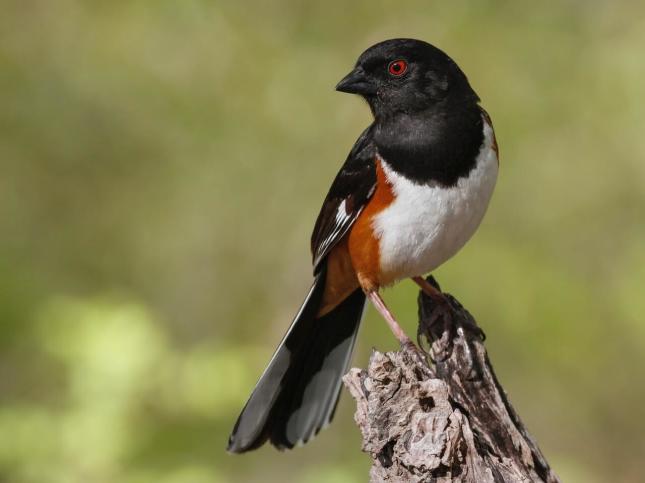
Fun Facts About Eastern Towhees
- A strikingly marked, oversized sparrow of the East, feathered in bold black and warm reddish-browns – if you can get a clear look at it. Eastern Towhees are birds of the undergrowth, where their rummaging makes far more noise than you would expect for their size. Their chewink calls let you know how common they are, but many of your sightings end up mere glimpses through tangles of little stems.
- You’ll typically see Eastern Towhees rummaging in the leaf litter or creeping through thick shrubs. Towhees tend to hop wherever they go, often moving deliberately and giving themselves plenty of time to spot food items. They scratch at leaves with a characteristic two-footed backward hop, then dart after anything they’ve uncovered. When a female first enters a male’s territory, he chases her as if she’s unwelcome. Over the next few days he becomes tolerant and then attentive, following the female everywhere she goes. Eastern Towhees have large white tail corners which they flick and flash in response to other towhees or when disturbed.
- Towhees eat many foods: seeds, fruits, insects, spiders, millipedes, centipedes, and snails, as well as soft leaf and flower buds in spring. They also eat seeds and fruits, including ragweeds, smartweeds, grasses, acorns, blackberries, blueberries, wheat, corn, and oats.
- Eastern Towhees usually nest on the ground, the nest cup sunk into the fallen leaves up to the level of the rim. In some cases they build their nests in shrubs or grape, honeysuckle, or greenbrier tangles, up to about 4 feet off the ground.
- Eastern Towhees tend to be pretty solitary, and they use a number of threat displays to tell other towhees they’re not welcome. You may see contentious males lift, spread, or droop one or both wings, fan their tails, or flick their tails to show off the white spots at the corners.
- The oldest known Eastern Towhee was at least 9 years old when it was recaptured and rereleased in South Carolina. It was originally banded in the same state in 1937.

